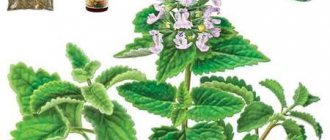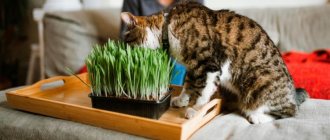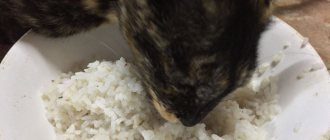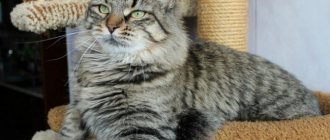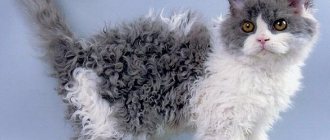This herb received the unusual name catnip precisely because it was very popular with representatives of the cat family. They are drawn like a magnet to this beautiful and fragrant plant. In ancient times, catnip was credited with magical properties and otherworldly powers. It was believed that such a plant had power over any animal. In the Middle Ages, sorcerers used the leaves of this herb, crushed into dust, to summon evil spirits, and young girls put dried catnip flowers under the pillow of their chosen one in order to thus bind him to themselves forever.
Features, characteristics
This genus includes more than 250 different species and varieties and likes to grow in dry, rocky soils. Mint is characterized as a perennial plant, but annual specimens are also found. The main criteria are:
- Height varies from 100 to 120 cm;
- The leaf blade is heart-shaped;
- The edges of the leaves have teeth;
- The color of the inflorescence ranges from white to blue;
- Each flower has four stamens;
- At the end of flowering, fruits are formed.
The peculiarity of this species lies in its emitted amber, which contains compounds called nepetalactone - it is this that has an effect on the behavior of cats.
Why do cats like the smell of mint?
The attractive aroma is associated with one of its components - nepetalactone. This is why animals remain indifferent to other scents, and because of this they lose control over themselves.
The principle of influencing a cat
Lemon balm - what it looks like, care instructions
With direct contact and inhalation of the scent, essential oils pass into the pet's respiratory tract, causing a signal that goes directly to the brain - the hypothalamus. The animal experiences a short-term effect reminiscent of drug intoxication, with hallucinations and a change in habitual behavior.
Note! The cats begin to purr, jump, run and roll on the floor like little kittens. The duration of intoxication does not exceed 15 minutes, after which the pet calms down and begins to doze for no more than half an hour.
This may then be followed by a repetition of the non-standard reaction.
When consuming catnip, the result depends on the pet’s body:
- a lazy and lethargic animal becomes playful;
- the overly active turns into a passive state;
- in some cases it may appear mad or drunk.
This condition should not cause concern; this is a normal reaction of the cat’s body to the active components of catnip. It contains no drugs and does not cause addiction.
For your information! Of particular interest to the researchers was the reaction of males to catnip. For male representatives, the essential oil evokes associations with a cat ready to mate.
The attractive appearance of the crop leads to mistakes by owners of personal plots. They often plant mint around the entire perimeter, including in mixes, making borders. The pungent lemon smell attracts wild bees and pets. Over time, overgrown bushes become a favorite resting place for cats, who at the same time hunt for insects. The result of improper planting is trampled valuable crops located next to the cat's joy.
Is catnip harmful to cats?
Dramatic changes in behavior lead to the idea that culture is harmful to the health of four-legged animals. Scientific studies have proven that it is absolutely harmless and does not lead to a drug-like addiction in the cat’s body.
Veterinarians remind us that moderation is needed in everything. In theory, pets themselves know when they need to stop in order to leave the world of dreams, but some individuals with weak characters arrange permanent beds in the thickets. Veterinarians include dyspeptic disorders when overeating fresh greens as serious consequences of contact with a hallucinogen.
The second problem is the animal’s non-standard behavior. If, after consuming weed, your pet behaves aggressively and rushes at any moving object, then you should stop communicating with the main source of hallucinations.
Important! Contact of animals bearing offspring with the miracle herb is strictly prohibited. Overstimulation of the nervous system can negatively affect pregnancy and the health of babies in the future.
The cat may not react to mint
Why doesn't my cat react to catnip?
Statistics indicate that almost 30% of pets do not perceive it as a hallucinogen. The peculiarity is associated with a hereditary predisposition: if the parents did not have certain receptors, then the next generation will be indifferent to catnip.
Note! Animals that have not reached sexual maturity are not susceptible to the essential oil of the culture. Their behavior after meeting lemon catnip will not differ from the standard; its components do not affect the young organism
Application
Since ancient times, the use of catnip in the food industry as an aromatic seasoning and additive to meat dishes and salads has been widely known. All above-ground parts above 10 centimeters of root nodes are considered edible. It is cut in mid-summer (June - August) when the plant blooms. Hang to dry for better air circulation in the shade. Suitable for consumption for 24 months.
On a note! If the harvest time is correctly observed and you know how to water, it will bloom again at the end of autumn. In this way, you can increase the supply of useful material.
In addition to a huge amount of essential oils, catnip has tannins, vitamin C, cardiac glycosides, and saponins. The essential oil is so rich in its composition that it works great as a powerful, antibacterial medicine.
Collection of greens
Catnip
Starting from the first year of life, if the plants have developed normally, the greenery of the catnip is cut off - young leaves and shoots at a height of 10 cm. This is done 2-3 times during the season, the first time at the beginning of flowering. To satisfy the family's need for fragrant greens, it is enough to have 5-6 plants in the garden.
Dry catnip greens in the air, under a canopy, in attics, in well-ventilated areas. The shelf life of raw materials is 2 years. Dried raw materials have a gray-green color. If the plant is mowed in the flowering phase, it grows back and blooms again in August-September. Catnip produces the highest and most consistent yield in the second or third year of life.
A new variety has been included in the State Register of Breeding Achievements - lemon catnip Blue Frost . It takes 55–60 days from germination to economic ripeness. The plant is erect, up to 60 cm high. The leaves are large, slightly wrinkled, bluish-green, pubescent, with white flowers. Inflorescences in the form of a brush are located on the edges of the stems. The aroma is strong, lemony.
Landing
Like any other plant, planting and caring for catnip in open ground is not difficult even for a novice gardener. Planting is done in early spring or autumn, after harvesting.
For more favorable cultivation for the first time, it is advisable to buy ready-made seedlings. They are often sold in specialized stores and markets. If you already have experience in gardening, then you can grow the plant from seeds.
Catnip seeds are planted in the following sequence:
- One day before planting, it is recommended to keep the seeds in the freezer;
- Having taken out the seeds, you should immerse them in a container of water and leave them for another day;
- Plant seeds in open ground or planting boxes;
- After 7 - 10 days, the first shoots should appear;
- After a short growth, the plants are planted at a favorable distance.
Pest and disease control
Catnip does not get sick too often due to the plant’s good immunity. In dry, hot summers it is affected by powdery mildew. Then it’s worth picking off all damaged leaves and treating the planting with fungicides. Mites and whiteflies appear less frequently, but complex preparations are also sufficient here.
In addition, very real and significant damage can be caused by cats attracted by the smell. That is why it makes sense to plant catnip separately and away from valuable crops.
Photo: zen.yandex.ru
Daisies (50 photos): types, planting and care in open ground
Key aspects of a successful landing
To grow a large and strong plant, just follow a few recommendations. The first thing to consider when planting in the ground is the distance between the bushes.
The bush will be pleased with an excellent harvest if it is planted at a distance of 0.3 - 0.5 meters from each other. An average of 6-7 bushes are placed on an area of 1 square meter.
If you want a denser composition, it is recommended to plant plants in pots so that their root systems do not intertwine and interfere with each other’s development.
Features
Do you know that most of the lemon balm sold, and as a result grown in gardens, is nothing more than catnip? And indeed it is. The plant looks very similar to lemon balm. But it is not difficult to distinguish one from the other.
You need to take the grass in your hands and grind it. If it is catnip, the smell will become unpleasant, but real lemon balm will retain its aroma. In addition, the dry grass of the plant in question slightly resembles the smell of cat urine. And another visual difference is that catnip fruits have two white dots. But this is not observed in lemon balm.
In ancient times, and in some countries to this day, the dry leaves of the named plant are chewed and smoked like tobacco. But in this form, of course, catnip does not reveal its medicinal properties. And the contraindications here, perhaps, even outweigh, since the grass to some extent turns into a drug. True, it will cause significantly less harm to health, unlike modern cigarettes. But getting used to such an action is evil in any case.
Watering
When planting catnip, the plant needs to be watered abundantly and regularly until it gets stronger. The average schedule includes 1-2 waterings per week. This principle should be followed for several weeks. During its adult vegetative stage, catnip only needs watering on very dry days.
Attention. The plant is a honey plant. When planning a planting site, you need to consider the proximity to bees.
Whether in the garden or in the vegetable garden
Since catnip looks very attractive, it is often included in flower mixes, borders and planted around the perimeter of the site. The fragrant aroma attracts some insects, especially wild bees (catnip is a valuable honey plant). Cats love to relax in the shade of lush bushes and have fun hunting crawling and flying “invaders”. Therefore, you should not plant this grass near valuable crops, since the cat will certainly trample the greenery growing around the catnip.
In order for catnip at home to delight you with its lush greenery and fragrant aroma, the soil in the pot should be light and not sour. Sufficient lighting and regular watering are important, but this plant does not like stagnant water at the roots.
Manufacturers of pet products have long figured out what catnip is for: since it is so attractive, why not use this property? Dried leaves can be hidden in a homemade toy or placed under the upholstery of a scratching post so that your pet is sure to use it. To make dietary food more attractive, you can add fresh catnip leaf or dried chopped grass to the dish.
Cats simply love toys with the scent of a simple plant - catnip. Some pets fall into euphoria, similar to, while others react more restrainedly. But there are few cats in the world who would be indifferent to the smell of catnip.
Catnip for cats is used as an aromatic stimulus (inducement to play, physical activity, awakening appetite) or a sedative (during sexual heat or severe stress).
Smells and, in general, the chemical composition of substances are much more important for cats than any other characteristics. So the smells of valerian and catnip have a tonic effect on our pets. Every catnip has known what catnip is since childhood - most commercial cat toys have this scent built into them.
Is it possible to give mint to a cat?
Beginning cat breeders believe that catnip is something like a narcotic. Not at all. Habituation (i.e., the development of immunity) is possible, but “drug addiction” is out of the question. The observed behavior is a momentary result, and not a manifestation of addiction.
In the case of valerian, the effect can still be destructive, since in case of overdose it leads to overexcitation of the nervous system and loss of control over behavior.
By the way, regular peppermint is not attractive to cats. Except sometimes – for individual gourmets. But it’s not for nothing that catnip was called that: it’s not interesting to humans, but cats are attracted to it in most cases. This is a safe plant, the delicate aroma of which has a mild, slightly intoxicating effect:
- Through the olfactory receptors, the aroma enters the body - directly to the hypothalamus, which is responsible for behavior. Hence such a quick and directed influence;
- The effect lasts 10-15 minutes, while valerian takes over the cat for several hours;
- A more pronounced hypnotic effect is observed compared to valerian. A dozing pet does not react to the smell again. Immunity lasts 1-2 hours.
Professionally Approved
Experts believe that the use of aromatic stimuli is an effective method in training and correcting the behavior of cats. Sometimes an animal needs to be concentrated on a certain place or object and form positive associations with it, for which catnip is ideal:
- In difficult cases, for example, when dealing with aggression, it is used as a sedative;
- As a phytocomponent, valerian and catnip are effective in correcting uncleanliness and destructive behavior (which also requires complex behavioral therapy and a course of re-education);
- It's good with catnip.
If your cat needs catnip, look in your local vacant lot: this free-growing plant can be found in almost any region. And if there is no time (or knowledge) for searching and preparing, then dried catnip greens are always sold.
It is best to look for it not on the lawn using a photo from the Internet, but in a pharmacy or specialty store. You can also grow it yourself on the windowsill all year round.
How does one cope with winter?
An already faded plant is cut 10 cm from the ground. In this condition, the catnip plant will survive even a very harsh winter. In the northernmost regions, it is recommended to cover the bush with hay or straw. When warm spring days arrive, you need to free the plant from its shelter to avoid the risk of root rot.
Is it harmful to cats?
Having eaten too much grass, the animal will begin to roll on the ground. Excessive consumption of the plant can cause the animal to meow loudly, convulsively move its paws, jump in place and roll on the ground. The Peppermint Cat often also hallucinates and experiences a feeling of euphoria. However, according to veterinarians, the symptoms do not pose a threat to the life and health of the animal. Veterinarians prohibit giving mint to pregnant cats, since excessive stimulation can have negative consequences for babies in the womb. There is a risk of premature birth. Mint is also harmful for cats, which react very sharply to odorous aroma - an outburst of emotions will deplete the central nervous system. With frequent use, sensitive pets will develop neurosis. The plant will not harm kittens and cats, but if the pet does not like catnip, then it should not be forcibly introduced into the diet.
Bush propagation
This fragrant, unpretentious bush can grow on its own, like a weed. In order for the plot to have a neat appearance and grow in the place where the gardener needs it, you need to monitor its growth and remove unnecessary sprouts.
The best time for these manipulations will be autumn. The plant to be divided must have at least three stems. Growing catnip is a great pleasure for beginners who love gardening beauty and benefits.
The Scientific Explanation of the Effects of Catnip on Cats
Scientists explain this effect on the cat’s body by the presence of a substance – nepetalactone, in the essential oil of the plant, which gives it a peculiar aroma. No serious scientific research has been carried out on this matter, therefore the mechanism of action has not been studied or described by science. It is assumed that nepetalactone molecules have a structure that allows them to act on the centers of pleasure and euphoria in the brain of cats. At the same time, no negative consequences or addiction are observed. The selective effect is explained by the different structure of the genome in different individuals, that is, in the genome of immune animals, there is no gene that is responsible for interaction with nepetalactone. The harmlessness of catnip for cats is also supported by the fact that in nature they “do not miss the pleasure of having fun” when they encounter this plant. As is known, all animals, at the level of instinct established by the experience of previous generations, avoid communication with environmental objects that pose a danger to them.
Photo of the catnip plant
Beneficial features
As a medicinal herb, catnip is used for a variety of purposes. So, it has the following effect:
- bactericidal;
- anti-inflammatory;
- antipyretic;
- painkillers;
- calming;
- sweatshop;
- antispasmodic;
- general strengthening;
- choleretic;
- anthelmintic;
- restoring the menstrual cycle.
The herb catnip, the medicinal properties of which we are considering, perfectly improves appetite, the digestive process, and normalizes intestinal function. Its use helps increase heart contractions and eliminate cramps. It will perfectly help with coughs, gastrointestinal diseases, bronchitis, migraines, hysteria, shortness of breath, anemia, jaundice and other diseases.
Article on the topic: Falcon Gorchak - beneficial properties, description
In addition to internal use, the plant can also be used externally. This is relevant for inflammatory skin processes, scabies, furunculosis, acne and eczema. Catnip essential oil will be effective in case of lead poisoning – it can improve the patient’s condition. The product also has a high antimicrobial effect. Decoctions and tinctures are usually made from it.
Let's look at a few ways to use Hungarian catnip. The healing properties of this herb are especially noticeable for depression, hysteria and angina.
To do this, make the following infusion: add a tablespoon of dry crushed herb to 300 ml of boiling water and leave to infuse for an hour. Then take half a glass three times a day.
The same recipe is suitable for external use for skin diseases.
For gastrointestinal diseases or headaches, make the following infusion: a small spoon of herb is brewed in 200 ml of boiling water and infused. It is best to do this in a thermos and then strain. The product is taken one tablespoon three times a day.
A mixture of herbs is also very effective. For example, for skin diseases, take St. John's wort, blueberries, mint, laurel, goldenseal, Irish moss, blue verbena, sorrel, fenugreek, yellow gentian, starube root, ash and, of course, catnip in equal proportions. Three tablespoons are poured into 400 ml of boiling water and left for an hour. At first, drink the tincture from the mixture once a day, gradually increasing the consumption up to three times.
If a child has insomnia, then you can prepare a decoction for him from a mixture that includes the following herbs: valerian, chamomile, passionflower, catnip, Baikal skullcap. All components are taken in equal proportions, three tablespoons are brewed with two glasses of boiling water and kept on fire for five minutes, then left for an hour. Use the product three times a day, 100 ml, for half a month.
Growing conditions
The perennial grows well in open, elevated areas where the soil is fairly dry and there is access to direct sunlight.
Catnip is unpretentious and does not require very nutritious soil. The main condition is sufficient dryness, looseness and breathability. The perennial does not tolerate heavy dense soils and excessive moisture.
Before planting catnip, the soil should be prepared; this is done in the fall. The site is dug up, getting rid of weeds, and organic or mineral fertilizers are applied. It can be compost or humus.

